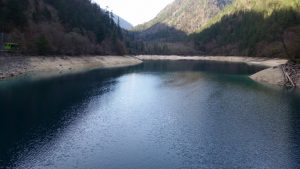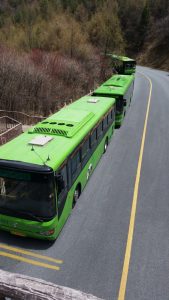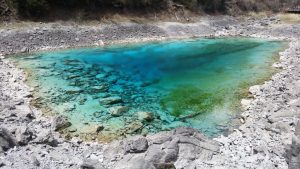When I arrived in China 6 weeks ago, my post-tour plans were not yet solidified. As I pondered how to best spend my research efforts, I debated whether the Jiuzhaigao region was worth the relatively expensive flights necessary to access this remote area of northern Sichuan. In the end I decided to go for it, and the travel gods rewarded my boldness. I’m sorry to retreat to my overused expression, but WOW!
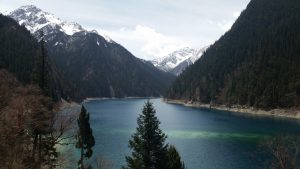
Jiuzhaigao National Park (JNP) is tucked into a remote valley in the far north of Sichuan. Primarily, it is culturally Tibetan, which I thoroughly enjoyed. On my personal spiritual sojourn, Buddhism has been resonant the past few years. Exposure to the Tibetan version was all bonus for me. I liked the music, architecture, and art and the people were friendly and welcoming. And the omnipresence of prayer flags and wheels were pleasant prompts to be mindful of loftier issues. And for me, time in nature, particularly the mountains, is an aid to moral and spiritual centering. As an added, more secular pleasure, the food was delicious. My favorite was Yak beef – yum.
 JNP consists of three valleys, two of which converge to form the third, forming a Y shape. I was put in mind of New Zealand’s south island, parts of the Alps, and Plitvice NP in Croatia. Pristine alpine lakes, surrounded by coniferous forests, granite mountains, and snowy peaks are connected by babbling streams and multiple waterfalls.
JNP consists of three valleys, two of which converge to form the third, forming a Y shape. I was put in mind of New Zealand’s south island, parts of the Alps, and Plitvice NP in Croatia. Pristine alpine lakes, surrounded by coniferous forests, granite mountains, and snowy peaks are connected by babbling streams and multiple waterfalls. 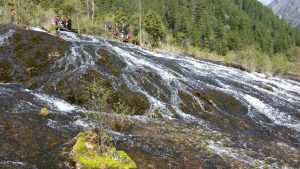 I arose early to be at the park entrance for opening, along with half the population of Sichuan apparently. I jockeyed for position and got my ticket and joined the zig-zagging cattle chutes that funnel visitors to the entrance control gate.
I arose early to be at the park entrance for opening, along with half the population of Sichuan apparently. I jockeyed for position and got my ticket and joined the zig-zagging cattle chutes that funnel visitors to the entrance control gate. 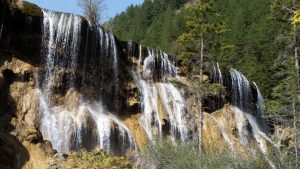 As always, the Chinese have dealt with the tremendous crowds in commercial fashion. Shuttle buses by the dozen line up to fill and depart, transporting a load (about 70 visitors) every minute. The shuttles drive to the top of the two valleys, without stops, alternating destinations with every other departure. Then the shuttles return to the Tourist Center at the confluence, stopping at scenic overlooks to deposit and collect visitors along the way. I lucked onto the shuttle I wanted, taking me to Bamboo Lake.
As always, the Chinese have dealt with the tremendous crowds in commercial fashion. Shuttle buses by the dozen line up to fill and depart, transporting a load (about 70 visitors) every minute. The shuttles drive to the top of the two valleys, without stops, alternating destinations with every other departure. Then the shuttles return to the Tourist Center at the confluence, stopping at scenic overlooks to deposit and collect visitors along the way. I lucked onto the shuttle I wanted, taking me to Bamboo Lake.
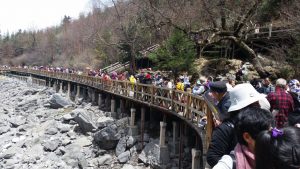 At Bamboo Lake, I alighted with my 69 new Chinese friends, to join several hundred more already at the overlook, wielding their selfie sticks like sabers, chattering at the top of their lungs, and putting on Tibetan costumes for yet more photographs of themselves.
At Bamboo Lake, I alighted with my 69 new Chinese friends, to join several hundred more already at the overlook, wielding their selfie sticks like sabers, chattering at the top of their lungs, and putting on Tibetan costumes for yet more photographs of themselves. 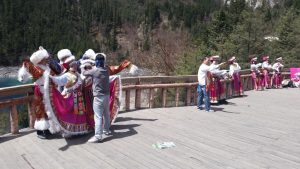 That sounds like a complaint, but I’ve learned about managing the Chinese tourist juggernaut – just walk. The Chinese seem not to care about being in nature, just photographing themselves there (or in front of whatever tourist site is the current objective). Their version of a perfect day in JNP, is to ride the shuttles down the two valleys, stopping at each scenic overlook for 10-15 minutes, take selfies, eat snacks, be loud, repeat.
That sounds like a complaint, but I’ve learned about managing the Chinese tourist juggernaut – just walk. The Chinese seem not to care about being in nature, just photographing themselves there (or in front of whatever tourist site is the current objective). Their version of a perfect day in JNP, is to ride the shuttles down the two valleys, stopping at each scenic overlook for 10-15 minutes, take selfies, eat snacks, be loud, repeat. 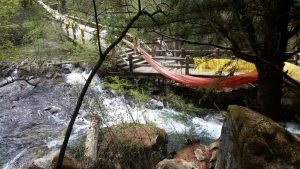 Which is fantastic for me! I left Bamboo Lake and started hiking down valley. Within moments I was alone, treading the perfectly uniform planked walking trail, passing other equally pristine and beautiful lakes, vistas, and streams. And it was all downhill – what a country!
Which is fantastic for me! I left Bamboo Lake and started hiking down valley. Within moments I was alone, treading the perfectly uniform planked walking trail, passing other equally pristine and beautiful lakes, vistas, and streams. And it was all downhill – what a country!
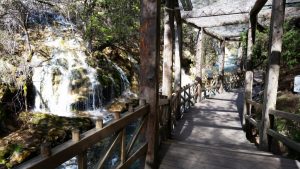 Aided by the uber-efficient Chinese system, I spent the entire day on manicured walkways, accessing spectacular natural sights, strolling ever and always steadily downhill.
Aided by the uber-efficient Chinese system, I spent the entire day on manicured walkways, accessing spectacular natural sights, strolling ever and always steadily downhill. 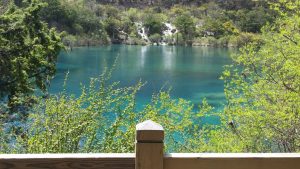 Highlights included Mirror Lake, Tiger Lake, Sparkle Lake, Five Color Pond, Long Lake (a mini version of Lake Louise in Banff NP Canada - see above), Lying Dragon Lake, and Nuoriling Falls. You gotta love the Chinese penchant for flowery language and names. I like waterfalls. I like them a lot. Some day I should analyze why. But on this day I just indulged in the refreshing experience.
Highlights included Mirror Lake, Tiger Lake, Sparkle Lake, Five Color Pond, Long Lake (a mini version of Lake Louise in Banff NP Canada - see above), Lying Dragon Lake, and Nuoriling Falls. You gotta love the Chinese penchant for flowery language and names. I like waterfalls. I like them a lot. Some day I should analyze why. But on this day I just indulged in the refreshing experience. 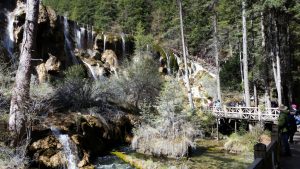 So the day’s big winner for me was magnificent Pearl Shoals Waterfall. It is no Victoria Falls, but it is nonetheless splendid. Hundreds of sparkling rivulets tumble down a sprawling travertine terrace. In addition to viewing the great stretch of splashing streams from below, it is easy to get an up close and personal view/photograph from the steps built next to the falls. I had to share the experience with hundreds of selfie sticks with Chinese tourists attached to them, but, you guessed it – WOW!
So the day’s big winner for me was magnificent Pearl Shoals Waterfall. It is no Victoria Falls, but it is nonetheless splendid. Hundreds of sparkling rivulets tumble down a sprawling travertine terrace. In addition to viewing the great stretch of splashing streams from below, it is easy to get an up close and personal view/photograph from the steps built next to the falls. I had to share the experience with hundreds of selfie sticks with Chinese tourists attached to them, but, you guessed it – WOW!
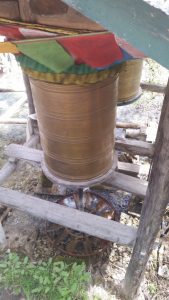 One last sight bears mentioning. Next to Shuzheng Lake the Tibetans have built a series of water-powered prayer wheels. Kept in constant motion by the flowing, living waters, the monks have created a perpetual prayer machine. It is not terribly picturesque, but it is truly fascinating.
One last sight bears mentioning. Next to Shuzheng Lake the Tibetans have built a series of water-powered prayer wheels. Kept in constant motion by the flowing, living waters, the monks have created a perpetual prayer machine. It is not terribly picturesque, but it is truly fascinating.
After my full day of walking, I indulged in a taxi ride back to my hotel, sought out a Chinese massage, and finished the day with a sizzling plate of yak steak and green vegitables, accompanied by some homemade barley wine. Yum.

